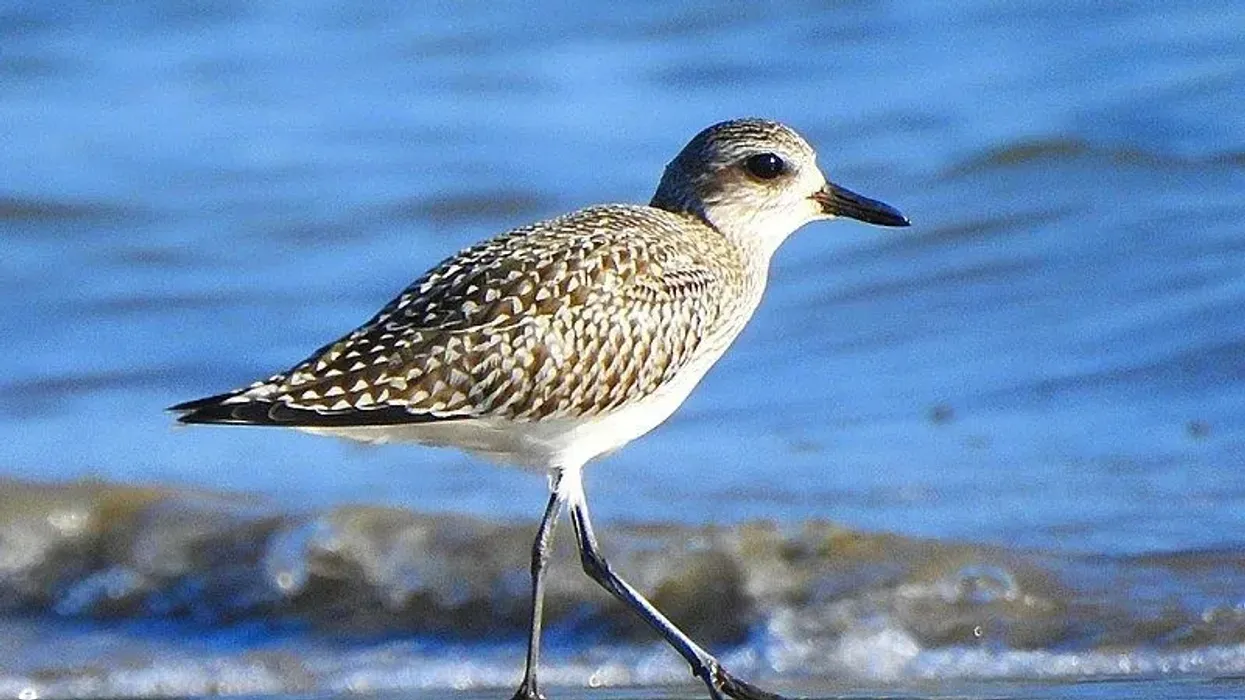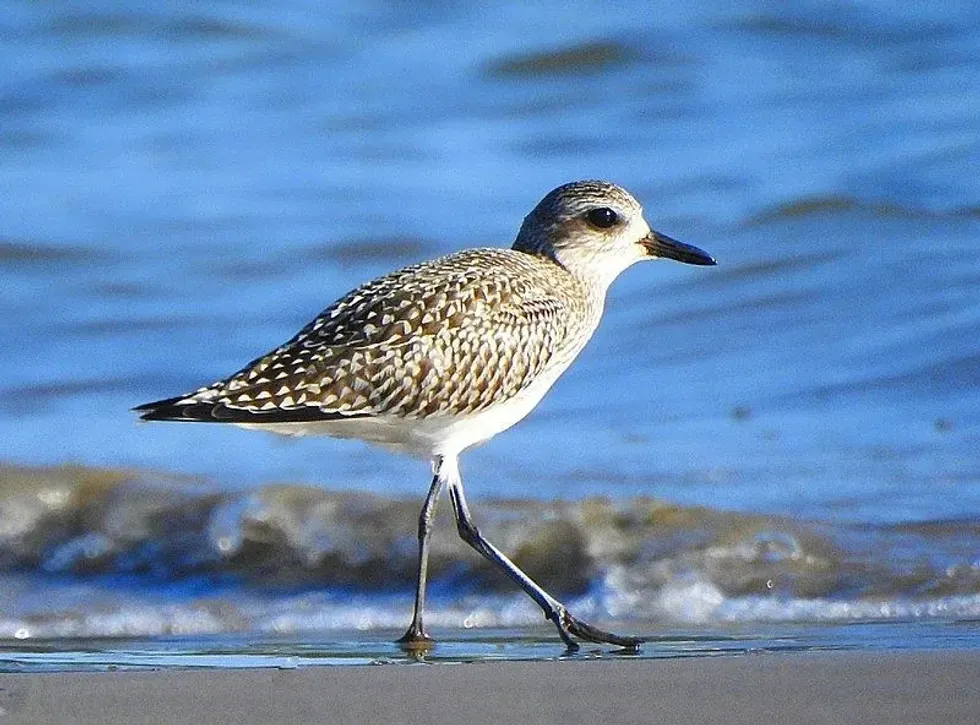How about discovering a bird taking long-distance migration in the winter and being present in most parts of the world? Come, meet our friend from the Arctic tundra, the Black-bellied plover, also known as Grey plovers outside North America.
These largest North American birds in the Plover family have a very diverse habitat range. They breed and nest in the range of Arctic Tundra. Their nest looks like a shallow depression surrounded by pebbles, and they nest 300 m within their previous breeding season's nest.
These North American shorebirds have a unique three-syllable flight call that sounds like 'pee-oh-wee.' They are generally ground foragers; they feed on insects majorly in the breeding grounds. Their sounds or calls are almost doleful and very distinct. These Grey plovers are one of the most widely found shorebirds. Their scientific name is Pluvialis squatarola.
Scroll down further to discover the fascinating world of this beautiful bird species. We have more interesting facts on King Rail and American Oystercatcher right here. Enjoy discovering more about some rare animal species with us
Black-Bellied Plover Interesting Facts
What type of animal is a Black-Bellied Plover?
The Black-bellied plover is a very popular waterbird commonly found in the Arctic region. In the non-breeding season, these birds are found worldwide in the coastal lines. They are known to take up migration for long distances.
What class of animal does a Black-Bellied Plover belong to?
The Grey plovers belong to class Aves. The animals in this class are distinguished by the presence of wings that are nothing but their modified forelimbs. These animals have ectothermic bodies, which means they are cold-blooded animals. In addition, they have a rigid skeleton and a unique respiratory system.
How many Black-bellied Plovers are there in the world?
A study in the wild has estimated the breeding population of the Black-bellied plover to be somewhere between 738,000-935,000 birds. But it is pretty sad to note that these bird species' populations show a declining trend.
The primary reasons for the population decline are habitat destruction or changes in habitat, global warming, predation in the wild, and the demand in the pet industry.
Where does a Black-Bellied Plover live?
These Black-bellied plovers are chiefly found in wetlands, tundras, coastal regions, and estuaries. The habitat range extends from Alaska in the U.S. to Argentina in South America to Canada and Russia. The winter season shows the bird population distributed across the coastal lines around the world.
What is a Black-Bellied Plover's habitat?
During the winter, the habitats of the Grey plovers are sandy beaches or muddy estuaries. They are also sighted in plowed agricultural lands and meadows near the coastline or inland marine waters.
They can be found at an altitude that ranges up to 328 ft (100 m) above sea level. They prefer the lowland nesting areas, and they are almost absent in high mountains.
Who do Black-Bellied Plovers live with?
These birds are migratory and depict group behavior. They are mostly seen with their flocks. They have unique alarm calls they sound to alert their flock of any imminent danger. They are highly territorial birds defending their territory with great vigor.
How long does a Black-Bellied Plover live?
The Black-bellied plover, Pluvialis squatarola, can live up to 10 years.
How do they reproduce?
When the breeding season arrives, these birds return to the breeding grounds typically in May and June. The male chooses the nest site by making a depression in the ground. The female fills these depressions with lichen willow, moss, and more. The width of the nest is about 5.3 in, and the depth is 1.8 in.
The female bird lays three to four eggs, and both parents undertake the incubation. It takes 23-27 days for the eggs to hatch. The young ones are ready to fly in 35-45 days.
What is their conservation status?
The IUCN Red List places these Grey plovers in the Least Concern category. The wide distribution of their habitat range with a healthy population count makes them a species of Least Concern. However, new studies indicate a decline in the population trend for these bird species.
Black-Bellied Plover Fun Facts
What do Black-Bellied Plovers look like?
The Black-bellied plovers are medium-sized. The male has magnificent breeding plumage with white in the upper parts during summer with some black spotting. The underparts are entirely black. The belly, rump, and the lower part of the tails are in the shade of white. Their black face, forehead, ear, and throat are black.
In the winter, non-breeding plumage is witnessed. In the black-bellied plover winter or non-breeding plumage, the upper parts are more grayish with white spots than the white upper parts of breeding plumage. The white belly and the white throat are found with few grayish-brown streaks. The axillary feathers gain a blackish color.
The black bill of the Grey plover is sharp and heavy. They have black irises along with black legs and feet. Their flight muscles are located between the breast and the belly.

How cute are they?
With their shimmering white and black body color, these docile birds become appealing to the eye. In addition, they fend for their groups which is another endearing quality.
How do they communicate?
Their communication is primarily acoustic in terms of the various calls. However, they watch out for the group members and give out special alarm calls to highlight the danger.
Swooping is another way they display their protective nature on their eggs. They are also known to feign injury to escape a predator. They protect injured birds in their flock by gathering around the injured ones.
How big is a Black-Bellied Plover?
The Black-bellied plover, Pluvialis squatarola, can grow as much as 33 in (83 cm). They are more significant than the Pacific golden plover. The Black-bellied plover is three times the size of the Pacific golden plover.
How fast can a Black-Bellied Plover fly?
The Black-bellied plovers are known to be magnificent flyers. This is evident from the fact that they take up long-distance migration during winter.
Their flight is consequential and direct, facilitated by the rapid wing beating. A unique feature to observe with these birds is that they would fly over the water in circles and land back behind the onlooker when they are disturbed.
How much does a Black-Bellied plover weigh?
The Black-bellied plover, Pluvialis squatarola, can weigh up to 9.9 oz (280 g). They are heavier than the Greater yellowlegs, weighing only 5.6 oz (160 g).
What are the male and female names of the species?
The male and female plovers are called cock and hen, respectively. The males are darker in coloration than the females.
What would you call a baby Black-Bellied Plover?
The baby Black-bellied plovers are called chicks or fledglings. The young Grey plovers look similar to the adult in the non-breeding plumage but with darker upper parts of the body and yellow spots.
What do they eat?
The Grey plovers eat small mollusks, crustaceans, bivalves, and insects. However, in their wintering grounds, they majorly feed on polychaete worms. Their eyes help them spot their prey quickly, even during the night. In the marine mudflat areas, they feed on marine worms and shrimps.
Are they dangerous?
The Grey plovers do not cause any intentional harm to humans. They are a safe species of birds. However, when they feel threatened, the most they do is when they would spread their wings and give a loud cry-like call.
Would they make a good pet?
These plovers do not make good pets being wild animals that are adapted better to survive in the wilderness. They are a migratory species, and it will be unfair to bind them in a cage. It is illegal to own a Grey plover in many parts of the world.
Did you know...
A group of plovers is called a brace, deceit, congregation, wing, or ponderance of plovers.
The Grey plovers are the largest in North America. They are dispersed on six different continents during the winter, but they come back for breeding in the Arctic Tundra.
The Grey plovers are the only plovers in America with a hind toe on the foot. Unfortunately, the hind toe is tiny and cannot be easily located.
Comparisons with other Plovers
The Grey plover is often mistaken for the Pacific golden plover. But let's see how we can differentiate these two birds apart. The Pacific golden plover vs Black-bellied plover shows that the Grey Plover is larger than the Pacific golden plover and enormous bill.
In addition, the Pacific golden plovers do not have a white rump like the Grey plover. The Golden plover has more yellow on its upper parts and black axillaries. They are similar to but not the same as the American golden plover.
Threats to the Black-Bellied Plover
The greatest threat to the Black-bellied plover is global warming and habitat destruction due to urbanization. Global warming has caused a temperature rise, which has affected these species of birds.
Warmer temperature zones have seen a decline in the population of the Grey plovers. Recreational activities and demand in the pet industry have also affected these North American birds in their habitat range.
The scientists at Audubon have done extensive studies on climate change on these bird species. They predict that a three-degree Celsius temperature increase will lead to a shift in 79% of the habitat for these birds.
Here at Kidadl, we have carefully created lots of interesting family-friendly animal facts for everyone to discover! Also, learn more about some other birds, from our willet interesting facts and laughing gull facts pages.
You can even occupy yourself at home by coloring in one of our free printable black-bellied plover coloring pages.









